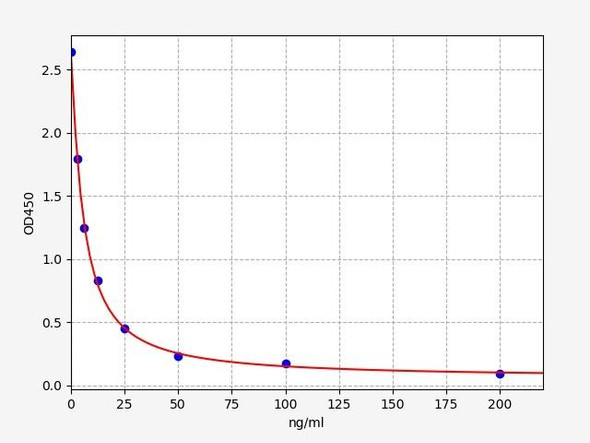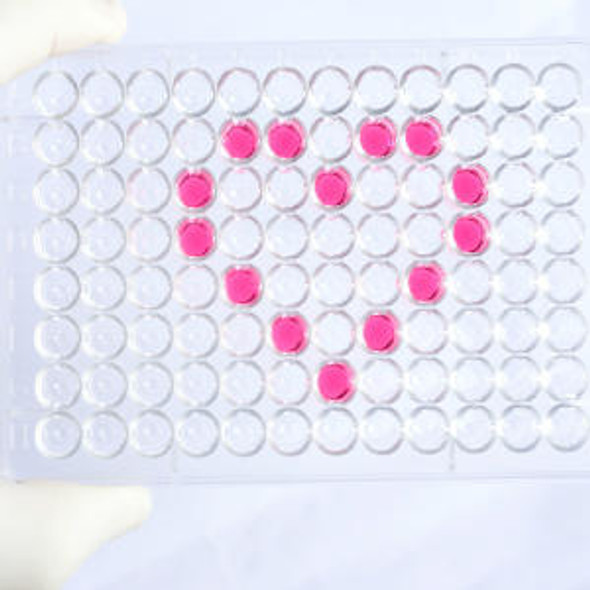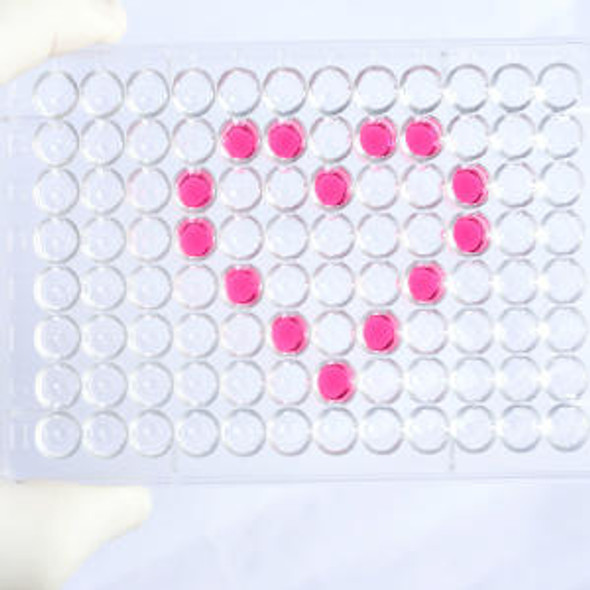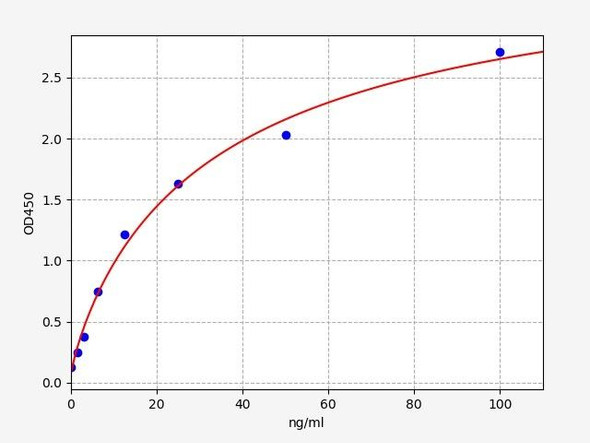Human Glycosylated Serum Protein ELISA Kit
- SKU:
- HUFI02529
- Product Type:
- ELISA Kit
- Size:
- 96 Assays
- Sensitivity:
- 46.875nmol/ml
- Range:
- 78.125-5000nmol/ml
- ELISA Type:
- Sandwich ELISA, Double Antibody
- Synonyms:
- GSP
- Reactivity:
- Human
Description
| Product Name: | Human Glycosylated Serum Protein ELISA Kit |
| Product Code: | HUFI02529 |
| Size: | 96 Assays |
| Alias: | GSP |
| Detection method: | Sandwich ELISA, Double Antibody |
| Application: | This immunoassay kit allows for the in vitro quantitative determination of Human GSP concentrations in serum plasma and other biological fluids. |
| Sensitivity: | 46.875nmol/ml |
| Range: | 78.125-5000nmol/ml |
| Storage: | 4°C for 6 months |
| Note: | For Research Use Only |
| Recovery: | Matrices listed below were spiked with certain level of Human GSP and the recovery rates were calculated by comparing the measured value to the expected amount of Human GSP in samples. | ||||||||||||||||
| |||||||||||||||||
| Linearity: | The linearity of the kit was assayed by testing samples spiked with appropriate concentration of Human GSP and their serial dilutions. The results were demonstrated by the percentage of calculated concentration to the expected. | ||||||||||||||||
| |||||||||||||||||
| CV(%): | Intra-Assay: CV<8% Inter-Assay: CV<10% |
| Component | Quantity | Storage |
| ELISA Microplate (Dismountable) | 8×12 strips | 4°C for 6 months |
| Lyophilized Standard | 2 | 4°C/-20°C |
| Sample/Standard Dilution Buffer | 20ml | 4°C |
| Biotin-labeled Antibody(Concentrated) | 120ul | 4°C (Protect from light) |
| Antibody Dilution Buffer | 10ml | 4°C |
| HRP-Streptavidin Conjugate(SABC) | 120ul | 4°C (Protect from light) |
| SABC Dilution Buffer | 10ml | 4°C |
| TMB Substrate | 10ml | 4°C (Protect from light) |
| Stop Solution | 10ml | 4°C |
| Wash Buffer(25X) | 30ml | 4°C |
| Plate Sealer | 5 | - |
Other materials and equipment required:
- Microplate reader with 450 nm wavelength filter
- Multichannel Pipette, Pipette, microcentrifuge tubes and disposable pipette tips
- Incubator
- Deionized or distilled water
- Absorbent paper
- Buffer resevoir
| Uniprot | P63092 |
| UniProt Protein Function: | G-alpha(s): a guanine nucleotide-binding protein of the G12 class of G-alpha proteins. Agonist binding to Gq-coupled receptors may block Akt activation via the release of active G-alpha(q) subunits that inhibit phosphatidylinositol 3-kinase. Heterotrimeric G proteins are composed of 3 units; alpha, beta and gamma. The alpha chain contains the guanine nucleotide binding site. |
| UniProt Protein Details: | Protein type:Oncoprotein; G protein; G protein, heterotrimeric alpha G(s); G protein, heterotrimeric; Vesicle; Membrane protein, peripheral Chromosomal Location of Human Ortholog: 20q13.3 Cellular Component: dendrite; extracellular region; cytosol; ruffle; transport vesicle; membrane; perinuclear region of cytoplasm; cytoplasm; plasma membrane; heterotrimeric G-protein complex; trans-Golgi network membrane; intrinsic to membrane; nucleus Molecular Function:GTPase activity; corticotropin-releasing hormone receptor 1 binding; ionotropic glutamate receptor binding; insulin-like growth factor receptor binding; signal transducer activity; protein binding; GTP binding; mu-type opioid receptor binding; metal ion binding; G-protein beta/gamma-subunit binding; beta-2 adrenergic receptor binding; D1 dopamine receptor binding; adenylate cyclase activity Biological Process: developmental growth; positive regulation of osteoclast differentiation; water transport; protein secretion; female pregnancy; embryonic hindlimb morphogenesis; G-protein signaling, adenylate cyclase activating pathway; intracellular transport; positive regulation of cAMP biosynthetic process; DNA methylation; tissue homeostasis; transmembrane transport; endochondral ossification; post-embryonic body morphogenesis; dopamine receptor, adenylate cyclase activating pathway; response to drug; sensory perception of chemical stimulus; negative regulation of multicellular organism growth; multicellular organism growth; adenylate cyclase activation; sensory perception of smell; embryonic cranial skeleton morphogenesis; positive regulation of osteoblast differentiation; cartilage development; energy reserve metabolic process; renal water homeostasis; cAMP biosynthetic process; blood coagulation; cognition; regulation of insulin secretion Disease: Osseous Heteroplasia, Progressive; Pseudohypoparathyroidism, Type Ic; Pseudopseudohypoparathyroidism; Mccune-albright Syndrome; Acth-independent Macronodular Adrenal Hyperplasia; Pseudohypoparathyroidism, Type Ia; Pseudohypoparathyroidism, Type Ib; Pituitary Adenoma, Growth Hormone-secreting |
| NCBI Summary: | This locus has a highly complex imprinted expression pattern. It gives rise to maternally, paternally, and biallelically expressed transcripts that are derived from four alternative promoters and 5' exons. Some transcripts contain a differentially methylated region (DMR) at their 5' exons, and this DMR is commonly found in imprinted genes and correlates with transcript expression. An antisense transcript is produced from an overlapping locus on the opposite strand. One of the transcripts produced from this locus, and the antisense transcript, are paternally expressed noncoding RNAs, and may regulate imprinting in this region. In addition, one of the transcripts contains a second overlapping ORF, which encodes a structurally unrelated protein - Alex. Alternative splicing of downstream exons is also observed, which results in different forms of the stimulatory G-protein alpha subunit, a key element of the classical signal transduction pathway linking receptor-ligand interactions with the activation of adenylyl cyclase and a variety of cellular reponses. Multiple transcript variants encoding different isoforms have been found for this gene. Mutations in this gene result in pseudohypoparathyroidism type 1a, pseudohypoparathyroidism type 1b, Albright hereditary osteodystrophy, pseudopseudohypoparathyroidism, McCune-Albright syndrome, progressive osseus heteroplasia, polyostotic fibrous dysplasia of bone, and some pituitary tumors. [provided by RefSeq, Aug 2012] |
| UniProt Code: | P63092 |
| NCBI GenInfo Identifier: | 52000961 |
| NCBI Gene ID: | 2778 |
| NCBI Accession: | P63092.1 |
| UniProt Secondary Accession: | P63092,P04895, Q12927, Q14433, Q32P26, Q5JWD2, Q5JWD4 Q5JWD5, Q6NR75, Q6NXS0, A6NI00, E1P5G5, |
| UniProt Related Accession: | O95467,P63092,P84996,Q5JWF2 |
| Molecular Weight: | 626 |
| NCBI Full Name: | Guanine nucleotide-binding protein G(s) subunit alpha isoforms short |
| NCBI Synonym Full Names: | GNAS complex locus |
| NCBI Official Symbol: | GNASÂ Â |
| NCBI Official Synonym Symbols: | AHO; GSA; GSP; POH; GPSA; NESP; GNAS1; PHP1A; PHP1B; PHP1C; C20orf45Â Â |
| NCBI Protein Information: | protein ALEX; protein GNAS; protein NESP55; secretogranin VI; extra large alphas protein; neuroendocrine secretory protein; guanine nucleotide regulatory protein; alternative gene product encoded by XL-exon; adenylate cyclase-stimulating G alpha protein; |
| UniProt Protein Name: | Guanine nucleotide-binding protein G(s) subunit alpha isoforms short |
| UniProt Synonym Protein Names: | Adenylate cyclase-stimulating G alpha protein |
| Protein Family: | Protein |
| UniProt Gene Name: | GNASÂ Â |
| UniProt Entry Name: | GNAS2_HUMAN |
*Note: Protocols are specific to each batch/lot. For the correct instructions please follow the protocol included in your kit.
Before adding to wells, equilibrate the SABC working solution and TMB substrate for at least 30 min at 37°C. When diluting samples and reagents, they must be mixed completely and evenly. It is recommended to plot a standard curve for each test.
| Step | Protocol |
| 1. | Set standard, test sample and control (zero) wells on the pre-coated plate respectively, and then, record their positions. It is recommended to measure each standard and sample in duplicate. Wash plate 2 times before adding standard, sample and control (zero) wells! |
| 2. | Aliquot 0.1ml standard solutions into the standard wells. |
| 3. | Add 0.1 ml of Sample / Standard dilution buffer into the control (zero) well. |
| 4. | Add 0.1 ml of properly diluted sample ( Human serum, plasma, tissue homogenates and other biological fluids.) into test sample wells. |
| 5. | Seal the plate with a cover and incubate at 37 °C for 90 min. |
| 6. | Remove the cover and discard the plate content, clap the plate on the absorbent filter papers or other absorbent material. Do NOT let the wells completely dry at any time. Wash plate X2. |
| 7. | Add 0.1 ml of Biotin- detection antibody working solution into the above wells (standard, test sample & zero wells). Add the solution at the bottom of each well without touching the side wall. |
| 8. | Seal the plate with a cover and incubate at 37°C for 60 min. |
| 9. | Remove the cover, and wash plate 3 times with Wash buffer. Let wash buffer rest in wells for 1 min between each wash. |
| 10. | Add 0.1 ml of SABC working solution into each well, cover the plate and incubate at 37°C for 30 min. |
| 11. | Remove the cover and wash plate 5 times with Wash buffer, and each time let the wash buffer stay in the wells for 1-2 min. |
| 12. | Add 90 µl of TMB substrate into each well, cover the plate and incubate at 37°C in dark within 10-20 min. (Note: This incubation time is for reference use only, the optimal time should be determined by end user.) And the shades of blue can be seen in the first 3-4 wells (with most concentrated standard solutions), the other wells show no obvious color. |
| 13. | Add 50 µl of Stop solution into each well and mix thoroughly. The color changes into yellow immediately. |
| 14. | Read the O.D. absorbance at 450 nm in a microplate reader immediately after adding the stop solution. |
When carrying out an ELISA assay it is important to prepare your samples in order to achieve the best possible results. Below we have a list of procedures for the preparation of samples for different sample types.
| Sample Type | Protocol |
| Serum | If using serum separator tubes, allow samples to clot for 30 minutes at room temperature. Centrifuge for 10 minutes at 1,000x g. Collect the serum fraction and assay promptly or aliquot and store the samples at -80°C. Avoid multiple freeze-thaw cycles. If serum separator tubes are not being used, allow samples to clot overnight at 2-8°C. Centrifuge for 10 minutes at 1,000x g. Remove serum and assay promptly or aliquot and store the samples at -80°C. Avoid multiple freeze-thaw cycles. |
| Plasma | Collect plasma using EDTA or heparin as an anticoagulant. Centrifuge samples at 4°C for 15 mins at 1000 × g within 30 mins of collection. Collect the plasma fraction and assay promptly or aliquot and store the samples at -80°C. Avoid multiple freeze-thaw cycles. Note: Over haemolysed samples are not suitable for use with this kit. |
| Urine & Cerebrospinal Fluid | Collect the urine (mid-stream) in a sterile container, centrifuge for 20 mins at 2000-3000 rpm. Remove supernatant and assay immediately. If any precipitation is detected, repeat the centrifugation step. A similar protocol can be used for cerebrospinal fluid. |
| Cell culture supernatant | Collect the cell culture media by pipette, followed by centrifugation at 4°C for 20 mins at 1500 rpm. Collect the clear supernatant and assay immediately. |
| Cell lysates | Solubilize cells in lysis buffer and allow to sit on ice for 30 minutes. Centrifuge tubes at 14,000 x g for 5 minutes to remove insoluble material. Aliquot the supernatant into a new tube and discard the remaining whole cell extract. Quantify total protein concentration using a total protein assay. Assay immediately or aliquot and store at ≤ -20 °C. |
| Tissue homogenates | The preparation of tissue homogenates will vary depending upon tissue type. Rinse tissue with 1X PBS to remove excess blood & homogenize in 20ml of 1X PBS (including protease inhibitors) and store overnight at ≤ -20°C. Two freeze-thaw cycles are required to break the cell membranes. To further disrupt the cell membranes you can sonicate the samples. Centrifuge homogenates for 5 mins at 5000xg. Remove the supernatant and assay immediately or aliquot and store at -20°C or -80°C. |
| Tissue lysates | Rinse tissue with PBS, cut into 1-2 mm pieces, and homogenize with a tissue homogenizer in PBS. Add an equal volume of RIPA buffer containing protease inhibitors and lyse tissues at room temperature for 30 minutes with gentle agitation. Centrifuge to remove debris. Quantify total protein concentration using a total protein assay. Assay immediately or aliquot and store at ≤ -20 °C. |
| Breast Milk | Collect milk samples and centrifuge at 10,000 x g for 60 min at 4°C. Aliquot the supernatant and assay. For long term use, store samples at -80°C. Minimize freeze/thaw cycles. |










